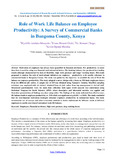| dc.contributor.author | Munyolo, W. A. | |
| dc.contributor.author | Oteki, Evans B. | |
| dc.contributor.author | Kimani, C. | |
| dc.date.accessioned | 2021-05-17T08:47:59Z | |
| dc.date.available | 2021-05-17T08:47:59Z | |
| dc.date.issued | 2015-12 | |
| dc.identifier.citation | International Journal of Recent Research in Social Sciences and Humanities (IJRRSSH) Vol. 2, Issue 4, pp: (5-14), Month: October - December 2015, Available at: www.paperpublications.org | en_US |
| dc.identifier.issn | 2349-7831 | |
| dc.identifier.uri | https://www.paperpublications.org/upload/book/Role%20of%20work%20life%20balance-479.pdf | |
| dc.identifier.uri | https://www.semanticscholar.org/paper/Role-of-Work-Life-Balance-on-Employee-Productivity%3A-Oteki-Chege/c8561be9af808e71a6ff8742372436559e10731c | |
| dc.identifier.uri | http://hdl.handle.net/123456789/4660 | |
| dc.description.abstract | Motivation of employees has always been quantified in financial attributes. For productivity to occur then there is need for using non-financial motivational initiatives. The banking industry has produced best trading results although characterized by lack of flexibility, high work pressure and longer working hours. This study purposed to analyze the role of motivational initiatives on employee productivity with specific reference to commercial banks in Bungoma County. The study was guided by the objective: to establish the role of Work life balance on employee productivity. The study adopted a survey design with a focus on 536 bank employees drawn from the different job cadres. A sample size of 229 was obtained using Yamane’s formula. Stratified sampling technique was employed with six strata’s obtained from six job cadres from top management to clerical staff. Structured questionnaires were the main data collection tools upon which analysis was undertaken using Statistical Program for Social Scientist (SPSS) where descriptive and inferential statistics was applied and thereafter presentations of findings was done using tables. The findings of the study indicated that effective work life balance leads to employee productivity r= .538 which was significant at p (0.00) < α (0.05). The study concluded that the non-financial motivation strategies influence employee productivity in commercial banks. The study recommends use of surveys and other evaluation methods to better understand the different needs of different employees to enable provision of customized work life balance. | en_US |
| dc.language.iso | en | en_US |
| dc.subject | Employees, Financial attributes, High work pressure, long working hours. | en_US |
| dc.title | Role of Work Life Balance on Employee Productivity: A Survey of Commercial Banks in Bungoma County, Kenya | en_US |
| dc.type | Article | en_US |

